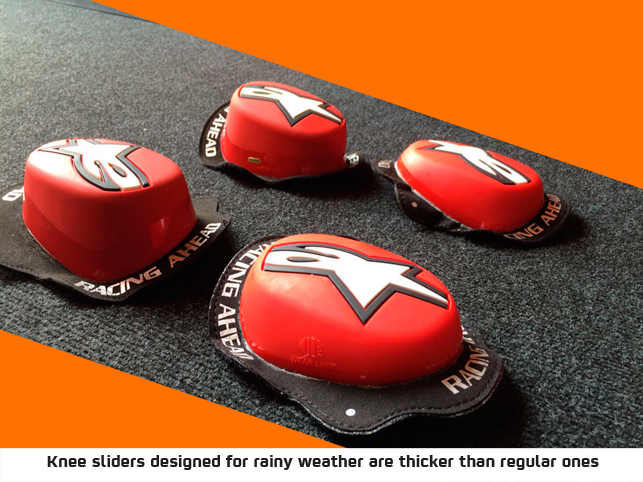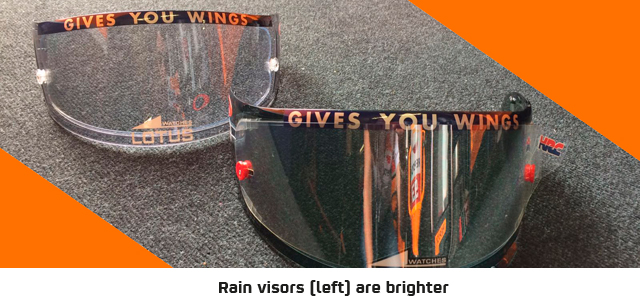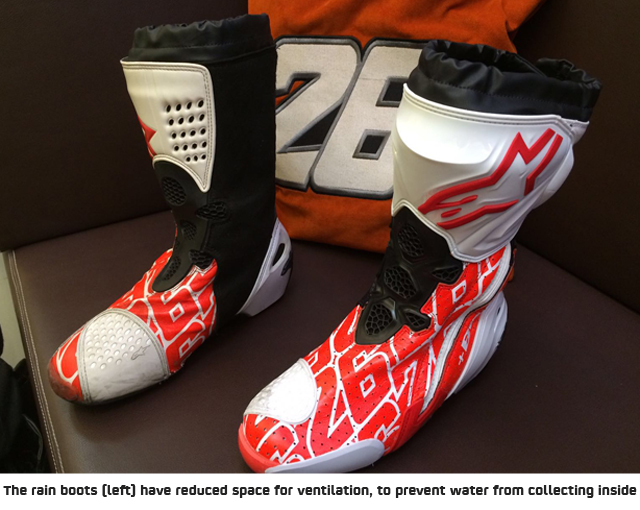The Helmet
One of the main negative effects of racing in the rain is that the high level of humidity increases condensation, which can fog up the helmet visor and the rider’s entire field of vision. Helmets used in wet conditions counteract this problem with more space for ventilation. However, this does not reduce the impact of another problem, which is mainly caused by a human factor that cannot be avoided: breathing. The helmets therefore have an attached mask that redirects exhaled air downwards, away from the visor.

Knee Sliders
Leaning a motorcycle to the side is dangerous, and while riders need to do this to achieve the best scores, they also have to bear in mind that they cannot do it with as much ease as in dry weather. Knee sliders worn in the rain are thicker than regular ones and touch the ground at an earlier stage so that the bike tilts less. Another advantage is that they offer greater protection should the rider fall from the motorcycle.

The visor
Helmet screens have different levels of brightness for dry and wet conditions. Darker screens counteract intense light and brighter screens improve vision in low light conditions. The range of helmet screens available for rainy weather tend to be brighter. They also have an internal screen, separated from the main one, that creates an air chamber to maintain a balanced temperature inside the helmet and reduce condensation. It is also important to keep the surface clean and dry using a special treatment process to waterproof the visor and reduce the impact of rainfall.

The gloves
Gloves used in rainy weather tend to be less stiff and lighter, making them more comfortable for the rider and allowing for greater dexterity when steering. The added comfort comes at the loss of protection from gloves designed for dry weather, which are thicker but make riding more complicated in wet conditions. The Repsol Honda riders make the final choice when deciding between comfort and protection, and this means that a wide range of gloves are used in rainy conditions.

The boots
Rain boots are only used for intense rainfall. They have reduced ventilation. The reason is simple: nobody likes to be knee-deep in water, and our riders are no exception. As with gloves, boots also tend to come in different varieties depending on the rider’s preferences for comfort and protection.

The suit
Finally, changes are also made to the rider’s suit. Although there are no specific suits used in races during intense rainfall, protecting the suit from water is very important, as the material is highly absorbent and can make it more awkward to compete. To prevent this from happening, waterproof products are added to boots, gloves and suits. And if things get really tough, riders can always put on their waterproof coats inside the box.
To summarise, rain equipment has distinctive features that take into account the shifting balance between factors such as protection, comfort and effectiveness in adverse conditions. Repsol Honda Team riders have to adapt to these conditions, and rain equipment is designed to help all competitors in this adaptation process to be able to give it their all during the race.


 Join Us
Join Us  Join Us
Join Us 